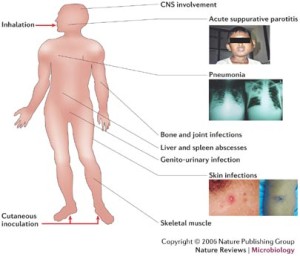Melioidosis is a disease that strikes fear in those who’ve heard of it.
 Doctors in Southeast Asia and Northern Australia know it as a stubborn, potentially deadly infection that causes pneumonia, abscesses and, in the most severe cases, organ failure. Without treatment it can kill within 48 hours. Military officials worry it could be converted into an agent of terror.
Doctors in Southeast Asia and Northern Australia know it as a stubborn, potentially deadly infection that causes pneumonia, abscesses and, in the most severe cases, organ failure. Without treatment it can kill within 48 hours. Military officials worry it could be converted into an agent of terror.
But for decades, melioidosis seems to have lurked under the radar of global public health organizations. “For everybody, it was a disease of southeastern Asia and Australia,” says Dr. Eric Bertherat of the World Health Organization. “But we are discovering that this disease is present in many other regions worldwide.”
A new study published Monday in Nature Microbiology says the bacterium causing melioidosis, Burkholderia pseudomallei, is living in the soil and water of 45 countries and is likely spread throughout another 34 countries, all wrapped around the tropics. “[The work] demonstrates the potential burden of this disease is much bigger than what everybody expected,” Bertherat says. “165,000 cases a year. It’s a big burden, equivalent to rabies, and that’s a severe disease.”
And the death rate can be high — “up to 70 percent,” says Bertherat. The study estimates there are about 90,000 deaths each year from melioidosis, roughly the same as measles and several times that of dengue.
For doctors in areas where the disease has long been common, the numbers are a grim confirmation of old suspicions. “For us, we think it’s a reasonable number. In northeast Thailand, I see 2-3 patients die of this during the rainy season every day,” says Dr. Direk Limmathurotsakul, a microbiologist with the University of Oxford and Mahidol University in Bangkok and lead author on the study. “When I went to Indonesia, every lab we looked, we found this disease. We feel this is a minimum number.”
The disease has probably been killing people in these countries for years, but it’s often missed, says Dr. Bart Currie, a microbiologist at Menzies School of Health Research in Australia who did not work on the study. Because the symptoms are so nonspecific, abscesses and fever and sepsis can all occur in other bacterial infections, melioidosis earned the moniker “the Great Mimicker.” “This very potentially dangerous bacterium is even harder to diagnose than the standard bacterium,” Currie says.
Misdiagnosis is a common problem in areas where the disease is not well-known — and can be fatal, says Limmathurotsakul. “It’s worrying for areas outside of our research center [in northeastern Thailand]. And we know that’s happening in many emerging areas – like India, Brazil, Indonesia,” he says.
- pseudomallei is naturally resistant to many commonly prescribed antibiotics. With good supporting care and access to proper medications, fatalities drop to around 1 in 10, and most healthy adults are able to survive an infection with good care. Otherwise, death sets in quickly. “There are many who have been treated with ineffective antibiotics for a period, says Limmathurotsakul. But by the time the disease is confirmed as melioidosis, he notes, “most of the time, the patient has already passed away.”
